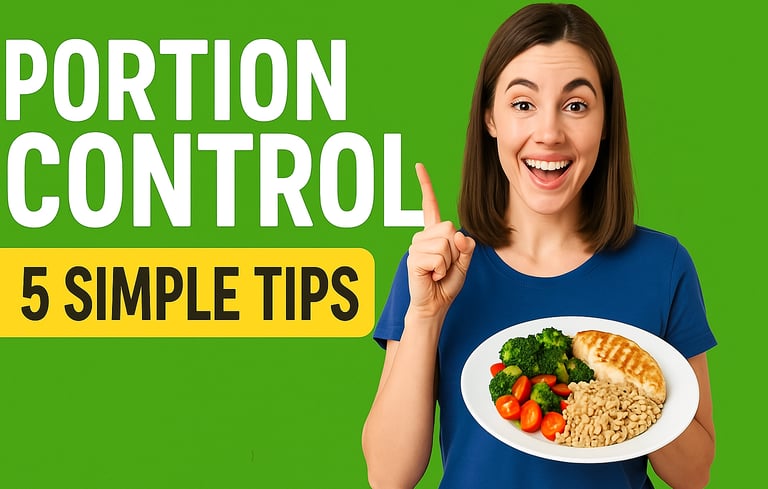✨ Kickstart Your Wellness Journey — Download the Free Detox Guide
Meal Portion Control: 5 Simple Tips to Stop Overeating and Eat Smarter Every Day
Master portion control with 5 simple, science-backed tips to stop overeating and eat smarter every day. Learn how to use smaller plates, hand-size portions, mindful eating, and balanced meals for lasting health, weight management, and better energy. Perfect for healthy living!
BLOG
8/9/20254 min read


Mastering Meal Portion Control: 5 Simple Tips to Stop Overeating and Eat Smarter
If you’ve ever found yourself overeating despite good intentions, you’re not alone. Portion control is one of the most effective, yet often overlooked, strategies to improve your nutrition, support weight management, and feel more energised throughout the day.
In this comprehensive guide, we’ll break down 5 easy and practical tips to help you master meal portion control, without complicated calorie counting or dieting. These are science-backed, easy-to-apply tricks that anyone can follow, whether you’re just starting your wellness journey or want to fine-tune your healthy habits.
Why Portion Control Matters
Before diving into the tips, let’s clarify why portion control is so important.
Overeating can happen for many reasons: large servings, distracted eating, or simply not realising how much food we’re putting on our plates. Consistently eating more than your body needs can lead to unwanted weight gain, sluggish digestion, and even blood sugar spikes.
By practicing portion control, you’re teaching your body to recognise true hunger and fullness cues. This doesn’t mean eating less food to feel hungry all the time. Instead, it’s about eating the right amount of nutritious food so you feel satisfied and nourished.
Tip 1: Use Smaller Plates to Trick Your Brain
One of the simplest tricks to eat less without feeling deprived is using smaller plates.
How it works:
Our brains are wired to respond visually. When you see a full plate, it signals to your brain that you’re getting enough food, even if the actual amount is smaller. Conversely, a large plate with a small amount of food can make you feel unsatisfied, causing you to eat more.
How to apply it:
Swap your regular dinner plate for a salad plate or a smaller dinner plate.
Fill it fully with your meal portions, this looks satisfying and helps reduce your overall intake.
This visual cue can significantly decrease the likelihood of overeating without you even noticing.
Science says:
Studies show people tend to eat 20-30% more calories when using larger plates compared to smaller ones, all because of how our brains interpret portion sizes!
Tip 2: Use Your Hand as a Portion Guide
Measuring food with cups and scales is not always practical. Instead, your own hand can be a handy, portable portion control tool.
The Hand Portion Guide:
Protein: A palm-sized portion (excluding fingers) is the perfect amount of protein for most meals.
Carbohydrates: Use your cupped hand to measure carb portions like rice, pasta, or potatoes.
Vegetables: Two fists together make a great serving size of vegetables, aim to fill half your plate with these.
Fats: Your thumb is roughly the right portion size for fats like nuts, oils, or butter.
Why it works:
This simple method adjusts for your body size naturally because larger people generally have bigger hands, which means they need larger portions. Plus, it removes the need for measuring tools, making portion control effortless anywhere, at home or dining out.
Tip 3: Fill Half Your Plate with Vegetables
Vegetables are nutrient-dense, fibre-rich, and low in calories, the perfect foundation for any meal.
Benefits of more vegetables:
The fibre in vegetables promotes fullness and aids digestion.
Eating a variety of colourful vegetables helps you get a broad spectrum of vitamins, minerals, and antioxidants.
They add volume to your meals, so you eat less calorie-dense foods without feeling hungry.
How to apply:
Always aim to fill half your plate with non-starchy vegetables like leafy greens, broccoli, peppers, carrots, zucchini, or cauliflower.
Experiment with different cooking methods, steamed, roasted, grilled, or raw.
Add salads or vegetable based soups as starters or sides to increase your vegetable intake.
Tip 4: Eat Slowly and Mindfully
How quickly you eat can be just as important as what or how much you eat.
The importance of mindful eating:
Your brain needs about 20 minutes to process signals from your stomach telling it that you’re full. Eating too quickly can mean you’ve already overeaten by the time your brain catches up.
How to slow down:
Take smaller bites and chew thoroughly.
Put your fork or spoon down between bites.
Pay attention to the flavours, textures, and aromas of your food.
Try to eat without distractions, turn off the TV and put your phone away.
The benefits:
Eating slowly improves digestion, reduces overeating, and enhances your enjoyment of food.
Tip 5: Pre-Portion Your Snacks
Snacking can easily sabotage your healthy eating goals, especially when you eat directly from large bags or containers.
Why pre-portion?
Helps you control calorie intake.
Prevents mindless munching.
Makes snacks more satisfying since you’re more conscious of what you’re eating.
How to pre-portion snacks:
Use small bowls, containers, or zip-lock bags to portion out servings of nuts, chips, dried fruits, or granola.
Plan your snacks ahead of time and keep them ready in your fridge or pantry.
Choose nutrient-dense snacks like fresh fruit, yogurt, nuts, or veggie sticks with hummus.
Bonus Tips to Support Portion Control
Here are a few more strategies to boost your portion control efforts:
Drink water before meals: Sometimes thirst is mistaken for hunger.
Avoid eating straight from the packet: It’s too easy to lose track of how much you’ve eaten.
Listen to your body: Stop eating when you feel comfortably full, not stuffed.
Plan your meals: Preparing meals in advance helps you control portion sizes and avoid last-minute overeating.
Keep a food journal: Tracking what you eat can increase awareness and mindfulness around portions.
Common Portion Control Mistakes and How to Avoid Them
Mistake 1: Skipping meals to “save calories”
Skipping meals can lead to excessive hunger and overeating later. Instead, focus on balanced meals with the right portions.
Mistake 2: Relying solely on calorie counting
Calories matter, but quality matters more. Focus on nutrient-dense foods and portion sizes, not just numbers.
Mistake 3: Ignoring hunger/fullness cues
Eat when you’re hungry, stop when you’re satisfied. Avoid eating out of boredom or stress.
Final Thoughts: Portion Control is About Eating Smart, Not Less
Portion control isn’t about starving yourself or obsessing over numbers. It’s a simple, effective way to help your body get the right amount of food to fuel your day, so you can feel energised, satisfied, and healthy.
By using smaller plates, leveraging your hand as a guide, filling half your plate with vegetables, eating slowly, and pre-portioning snacks, you’ll create a sustainable eating routine that supports your wellness goals.
👉 Visit: www.thevibewell.com and join our community for more wellness support.
Did you find this guide helpful?
Drop a comment below with your favourite portion control tip or any questions, we love hearing from you!
And don’t forget to subscribe for weekly nutrition and wellness tips that help you live your healthiest, happiest life.
The Vibe Well
The Vibe Well is your go-to space for natural wellness, faceless health courses, and everyday inspiration to feel your best.
© 2025. All rights reserved.


